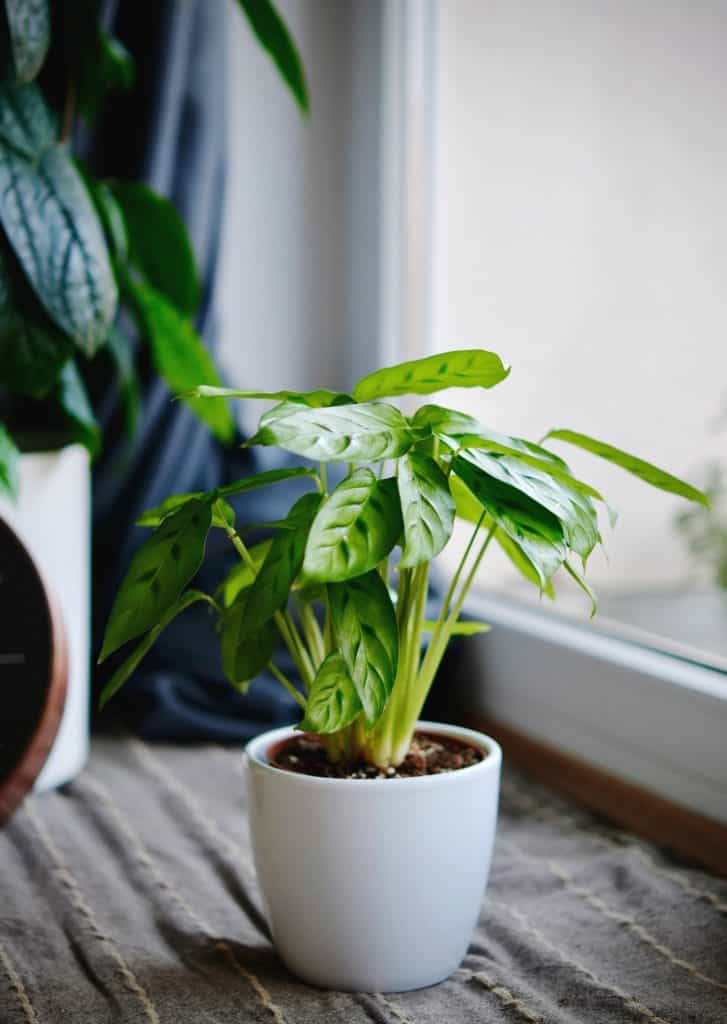| Common Name(s) | Shadow Plant |
| Scientific Name | Calathea Leopardina, syn. Geoppertia concinna |
| Sun Exposure | Indirect bright light |
| Soil pH | 6.5 |
| Watering Requirement | Moist but not soggy |
| Hardiness Zone | USDA 8 and up |
| Plant Height | 2 Feet |
| Plant Width | 6-7 inches |
If adding a plant with beautifully, unique variegation is on your bucket list, you’ll probably want to check out Calathea Leopardina. This plant shows off a stunning pattern of pastel green to neon green leaves with darker spots emerging from the center vein. The leaves are shaped like spearheads and are luscious and tropical.
Calathea Leopardina originates in the Brazilian rainforest and loves to show off peacock fashion by having long stems and spread out leaves. This also helps it to get as much sunlight as possible while living under the tall tree canopy.
While Calathea Leopardina is a member of the Marantaceae or prayer plant family, they tend to be more resilient and adjustable than their other prayer plant relatives. They are nyctinastic, which means they follow a circadian rhythm. Their leaves fold each evening, like praying hands, and open in the morning to soak up the light. Unlike other prayer plants, Calathea Leopardina does not have a purple or maroon underleaf.
Other names for Calathea Leopardina are shadow plant and Geoppertia concinna.

What are the benefits of keeping Calathea Leopardina?
Like all plants, Calathea Leopardina exchanges the carbon dioxide in your environment for oxygen that it willingly volunteers back into the atmosphere. Calathea Leopardina also filters other debris and toxins from the air making it an excellent plant to have if you are concerned about breathing in pollutants in your home or office.
Calathea Leopardina Care
Compared to other Marantaceae family plants, whose care includes very specific and rigid humidity, water, and light requirements, Calathea Leopardina is much easier to care for. Calathea Leopardina is much more adaptable than its cousins.
How to care for Calathea Leopardina as an indoor plant
You will want to be sure the temperature, humidity, soil, and container are all optimal for Calathea Leopardina. It should be planted in a pot with drain holes and make sure the saucer or tray on the bottom that catches the water is emptied to avoid having your Calathea Leopardina left sitting in water.
Caring for Calathea Leopardina as an outdoor plant
Outdoors, Calathea Leopardina requires a shady spot, to emulate its natural environment under the tree canopy of the Brazilian rainforest. in a warm climate. Their soil should be well-draining and light. Calathea Leopardina does not tolerate frost.
Lighting Requirement
Bright, indirect sunlight is the very best for Calathea Leopardina. East or North facing windows, where light is available, but not harsh, and beading down on the plant is a fantastic arrangement for Calathea Leopardina. If the only options are West or south-facing windows try dampening the light with a sheer curtain.
Soil Type and pH Requirement
Plant your Calathea Leopardina in light and airy, well-draining soil. Heavy soil will put pressure on the roots and damage your plant. Some commercial mixes are available on the market that make excellent substrates for Calathea Leopardina.
If mixing your own soil try, one part potting soil, one part sand, and one part perlite.
The best pH for Calathea Leopardina is 6.5.

Watering Requirement
Calathea Leopardina should be consistently moist. Water your plant when approximately the top inch of soil is dried out. Let the pot drain onto a tray and then remove the water from the tray to avoid having your Calathea Leopardina sitting in water. They do not appreciate soggy, over wet soil at all.
Calathea Leopardina has a sensitivity to minerals in tap water so be sure to give your water at least 12 hours time sitting out to allow the minerals to dissipate. An alternative would be using distilled water or filtered water to water your Calathea Leopardina.
Humidity Requirement
While more forgiving than other plants in the Marantaceae family, Calathea Leopardina is very big on humidity. The optimal humidity level for them is 80% or higher. This can be achieved in a few different ways.
One way is to mist your plant’s leaves every 1-2 days, or you can invest in a humidifier for your Calathea Leopardina, lastly, if you have quite a few plants with similar humidity requirements, try grouping them together so they can gather humidity from each other’s resources. A combination of these ideas may be necessary to keep up sufficient humidity.
Temperature Requirement
Calathea Leopardina is used to the very warm temperatures of Brazil and likes to be kept cozy. Keep temperatures between 65F and 80F for prime growth. Temperatures under 59F can wreak havoc on your Calathea Leopardina. It is the cause of stunted growth, shock and even death.
Additionally, avoid having your Calathea Leopardina near drafty doors and windows, and heating and cooling vents.
Calathea Leopardina Hardiness Zone
A hardiness zone of USDA 8 or above is ideal for Calathea Leopardina.
Calathea Leopardina Propagation
Propagation of Calathea Leopardina is best planned for when your plant needs to be repotted.
Gently remove your Calathea Leopardina from its container, jiggle the roots to get this oil off, and plan how you will divide your plant to create multiple Calathea Leopardinas.
Each divided section should have a minimum of five healthy stems.
Use a sterilized knife to slice carefully through the roots. Rubbing alcohol is sufficient to sterilize the blade.
Using as many containers as you have plants, repot each of the cuttings into their own individual pots with fresh clean soil. Make sure they have drainage holes.
Keep an eye on your plants as they will probably go into shock and may need some extra attention to recover.
Calathea Leopardina Size and Growth
Calathea Leopardina stems grow vertically and can be as tall as 2 ft.
Its leaves grow to be between 5 and 7 inches long. As the leaves mature they eventually weigh the stems down and cause them to spread. This makes the plant appear broader.
In ideal conditions, Calathea can have a growth rate that is moderately fast. It will reach its full size in 2 to 3 years.
Common Problems with Calathea Leopardina
If your Calathea Leopardina soil is too dry it may attract spider mites. The best way to cure spider mites is to separate the affected plant from any others. Give your plant a spray down with water and then use horticultural soap or rubbing alcohol to ensure the spider mites are gone for good.
Leaves curling
Leaves curling is a sign your Calathea Leopardina is trying to preserve itself due to dehydration. Leaves curling is how a plant tries to prevent water loss. Give your Calathea Leopardina a nice drink of water and monitor it to make sure it is watered regularly.
Leaves turning yellow
If the leaves on your Calathea Leopardina are turning yellow there are a couple of possibilities. It could be overwatered or it might not be receiving enough sunlight.
If the soil is too wet, let it dry out before watering again. If the soil is just moist and not soggy, move your Calathea Leopardina to a spot where the sunlight is brighter.
Leaves with brown edges
Brown crispy leaves require a little bit of troubleshooting. On one hand, it may be a case of not enough water, but if you are a faithful waterer and monitor the soil for moisture, the problem is probably your Calathea Leopardina is in sunlight that is too direct. Move it away from the window or to a different less sunny location.
Drooping leaves
Drooping leaves could mean there is a draft or a drastic temperature change in your Calathea Leopardina’s environment. Move it to a warmer. Less drafty spot.
As with most problem symptoms for Calathea Leopardina check to make sure your plant is not too dry or too wet.
Plant Dying
Root rot is the most common cause of death for Calathea Leoparina. The soil your Calathea Leopardina is planted in can not be too soaked or root rot will set in and it rarely can be cured.
How to repot Calathea Leopardina
Uproot your Calathea Leopardina with care. Tenderly shake the bottom to get excess soil off the roots. Fill a container with drain holes in the bottom one-third with soil. Place your Calathea Leopardina on top of the soil and fill it with more soil around it. Water the plant and place it in indirect sunlight. Monitor it for signs of shock.
Do Calathea Leopardina Flower?
In their jungle home, Calathea Leopardina will flower, however, it is very rare to see them flower when living indoors. When they do bloom their flowers are small white blossoms.
Does Calathea Leopardina move at night?
Being part of the prayer plant family Calathea Leopardina leaves do fold up at night, resembling praying hands, and then open back up in the morning to greet the sunlight.
Is Calathea Leopardina safe for pets?
Calathea Leopardina is not toxic and is safe for both cats and dogs.
Where can I find Calathea Leopardina for Sale?
Calathea Leopardina can be found online and in brick and mortar specialty plant stores. Prices for Calathea Leopardina have quite a large range and can be as low as USD 15 up to USD 55 and higher.
